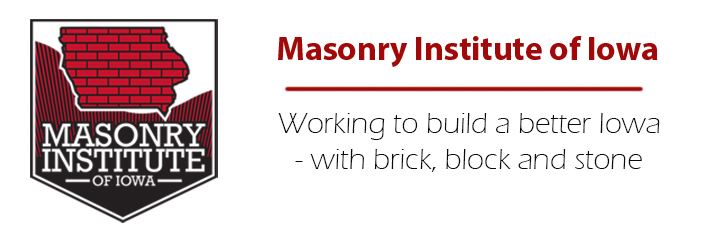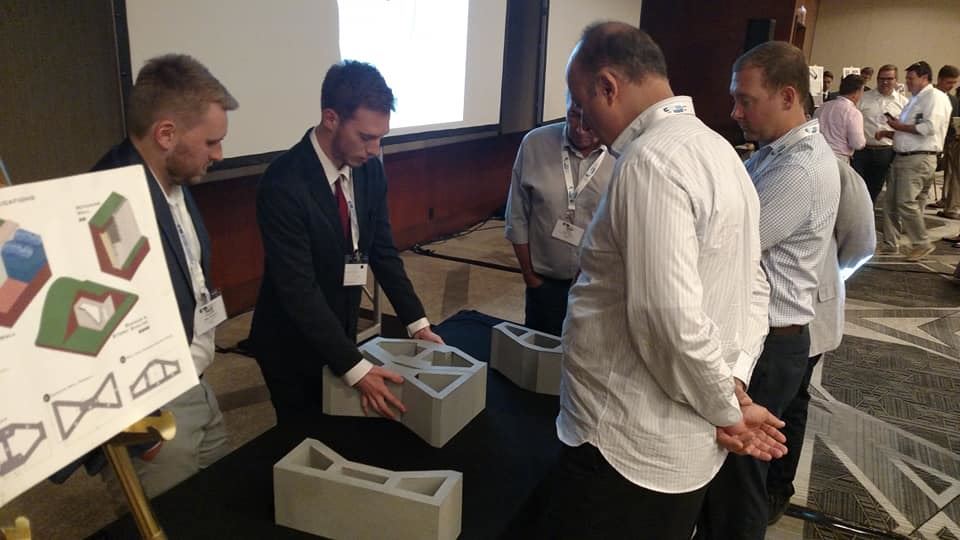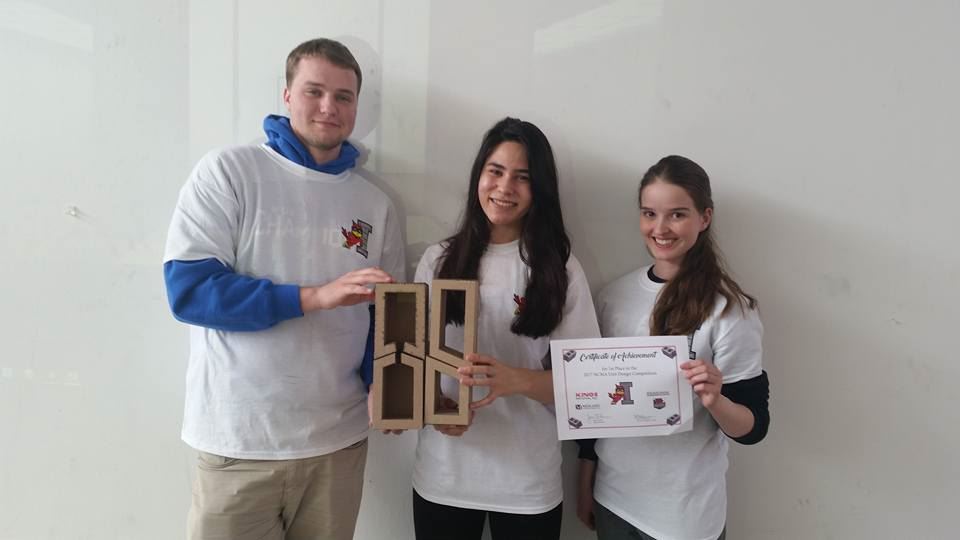
Masonry Institute of Iowa
PO Box 393
Johnston, IA 50131
Phone: 515-252-0637
The Goal is to design a new concrete masonry or hardscape unit that can be manufactured on a block machine or a big-board machine. The unit you design is to be conceived as a mass produced unit with potential architectural or landscape applications.
2022 Unit Design Competition Winners
2021 Unit Design Competition Winners
2020 Unit Design Competition Winners
2019 Unit Design Competition

2018 Unit Design Competition


Seismic-Block: Mike Oddo, Rodcely Muro-Garrido, Tyler Vincent, Nick Blazek


Congratulations to the 2017 ISU team for receiving 1st place at this year's national competition!



OBJECTIVE:
To understand the relationship between a specific material and a form made using that material. There are no preconceived “ideal” solutions to this project. Instead, the emphasis is placed on understanding the implications of your decisions and on making a series of related decisions about a form and its material. Explore alternatives and try to understand the tradeoffs of each decision.
Concrete masonry or hardscape units are an abundant but underutilized part of the designer’s palette. This product is a durable material that can be used to carry weight, enclose space, and perform a variety of utilitarian functions in buildings and the built landscape. Because it is a manufactured material, its texture, color, shape and size are controllable features. A wide variety of concrete masonry or hardscape products are available and new ones can be proposed.
This project will be part of a student competition in unit design. Your work will be evaluated by the faculty in this course as one of your exercises. In addition, you are also expected to submit your project for review by the competition jury (generally a Saturday morning event hosted by the Local Masonry Association and/or the local producers). The winner of the unit design competition will go on to compete on a national level. The project grade for this course is not affected by the outcome of the competition jury.
TEAM SIZE:
4 people
UNIT DESIGN:
A Concrete Masonry or Hardscape Unit: Design a new concrete masonry or hardscape unit that can be manufactured on a block machine or a big-board machine. The unit you design is to be conceived as a mass produced unit with potential architectural or landscape applications. What are concrete masonry or hardscape units? What do they want to be? What could they be used for? Your design should capitalize on the advantages offered by concrete masonry or hardscape as a material, a fabrication process and a use, while accommodating for the associated weaknesses. The design of the unit should conform to the following practical considerations:
1. ‘Box’ size: The ‘box’ that concrete masonry or hardscape units are molded in measures 16″wide x 24″long x 8″ high. It is important that the unit or units you design can be cast in this box.
2. Shape must be extruded when molded: After the units are cast, the mold lifts up vertically, leaving the units behind on the table. The units are only in the mold for a few seconds. This means that the shape you are casting is basically extruded vertically. To be extruded, it must have a consistent cross section in the z (vertical) axis when being cast. Protrusions or holes in the x and y axes are difficult to make. However, core pullers and other emerging technologies in unit production to accommodate these features are available and allowed.
3. Efficiency: The manufacturers have invested a lot of capital in this equipment, and want to make a few dollars off of each cycle of the molding machine. To do so, either the units must have a high profit margin, or they must make a lot of units in each cycle – preferably both. Try to make it so that your units occupy at least 90% of the “box” each cycle.
4. Stable shapes: Concrete masonry or hardscape units are strong when cured, but are weak for the first few hours. To avoid the unit crumbling or cracking while it is being handled, make the minimum thickness of the unit at any point about 1″. Avoid acute angle shapes of less than about 60 degrees, because the corners tend to not get filled in the mold and are vulnerable to getting broken later in transit.
Submission: To clearly illustrate the design intentions the following drawings are required prior to the competition for course grading and during the competition for competitive judging (scale 1″ = 1′-0″):
Overall view of an assembly using the masonry unit(s) you designed, as well as non-masonry components such as adjoining materials, masonry accessories, etc. This drawing should show how the masonry units would be used in a plausible architectural application. This should be a series of perspectives, axonometric or isometric drawings, using color to represent the appearance of the materials. Include notes to briefly explain your proposal and its intended application.
Prototype Model of the unit or units you design. This may be made of any material. It should be made to represent accurately the colors and textures of the units you propose. It is important to make a minimum of 4-6 so the interplay of units may be physically explored. The models should be full or half-scale.
General note: all drawings must be mounted on 11″ x 17″ boards (three boards maximum). Use color to represent those of the materials. Restrict identifying remarks in your submission to the back of the board; do not put your names or other identifying marks on the front of the boards or on the prototype models. All competition entries will be judged during the day of the competition.
ASSESSMENT CRITERIA:
The drawings and the prototypes will be evaluated in terms of the following ranked criteria:
-
use of modular coordination
-
manufacturing efficiency
-
innovation
-
technical performance (potential stability, weathering resistance)
-
quality of craft and presentation (clear drawings, well constructed prototype, graphic appeal, etc.)
LOCAL COMPETITION:
Sponsored by King's Material and Masonry Institute of Iowa
Prizes:
1st $250/team, tshirts & certificates
2nd $150/team, tshirts & certificates
3rd $100/team, tshirts & certificates
Honorable Mention Certificates
NATIONAL COMPETITION
First place teams from each participating university competition are invited to participate in the national competition. Invitations will be distributed in the spring of each year. Participating teams will ship displays and prototype units to the national judging location, the venue of which changes from year to year. For consistency of materials, displays for the national competition are to be limited to three 11 x 17 boards and 4 to 6 full- or half-scale prototype units. The same limitation for identifying markings applies as for the local competition. Personal appearance of the teams will not take place at this event.
The top three teams from the national competition then will be provided transportation and lodging to present their designs at the NCMA Midyear Meetings generally held in the July/August timeframe each year.
An award ceremony will follow the presentations where the final ranking of the top three teams will be revealed and prizes awarded (four students maximum per team).
Prizes:
1st $250/Student
2nd $150/Student
3rd $50/Student